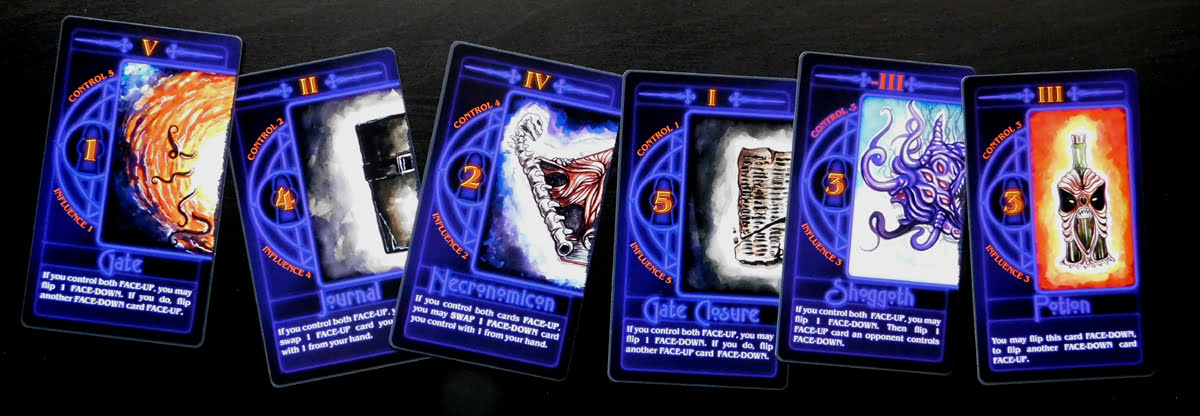
We’ve all been there: it’s a Friday evening, you want to go home, throw on sweatpants, and watch Netflix, but those oh-so-pesky cultists next door just have to summon an elder god tonight. So instead of bingeing on hot wings and House of Cards, you’ve got to keep the world from ending at least one more night.
What Is Seals of Cthulhu?
Admittedly, the game (currently on Kickstarter for a pledge level of $12) doesn’t present itself as whimsically as I may have implied. But Seals of Cthulhu plays so quickly and is so breezy that it immediately sets itself apart from the myriad stacks of grim-dark games that pit a plucky team of cultists against the great old ones. In fact, the trope of investigators vs. Cthulhu has become so prevalent of late that Sean Epperson’s addition to the genre–a 2-player game that plays in about 15 minutes–is a breath of fresh air in a genre that’s beginning to suffocate under its own weight.
(New to Kickstarter? Check out our crowdfunding primer, and visit our Kickstarter curated page for more projects we love.)
What’s in the Box?
Seals of Cthulhu is a trim, sparse little game, with a footprint on par (or smaller) than games like Love Letter or BraveRats. While the current Kickstarter includes provisions for a number of expansion cards, the core game itself comes with the following:
- 4 Green cultist influence meeples
- 4 Blue investigator influence meeples
- 6 Core investigator cards
- 6 Core cultist cards
- 1 Active player token
Note: the following components are included in the base game but are used to add variety to the game and aren’t required for the basic version of play.
- 4 Cultist ID cards
- 4 Investigator ID cards
- 2 Cthulhu cards (1 for the cultist, 1 for the investigator)

So really, to play Seals of Cthulhu all you need is 6 cards and 4 meeples each and you’re ready to go. But these aren’t just “cards” in the traditional sense. Oversized and crisp, publisher Thing 12 Games made a smart move. If your game is made up of 12 cards and not much more, then you’ve got to grab people’s attention with those cards. Roughly the size of a tarot deck and sporting gritty-but-intuitive design, Seals of Cthulhu does just that. While the art wasn’t 100% complete at the time of this review, what I’ve seen is subtle, evocative, and perfectly suited to the needs of the game.
Otherwise, the only components of the game are 8 influence tokens (which are currently in the form of meeples, though that may be different in the final version) and an unnecessary active player marker. Which is fine. There’s no padding here; this is a game that knows what it’s about and puts as little as possible between you and getting it to the table.

How to Play Seals of Cthulhu
Are you paying close attention? Like I always tell people when we’re driving through my hometown of Wanamingo, MN: “Don’t blink or you’ll miss it.” Gameplay for Seals is similar, so keep both eyes open.
Setup
Each player takes the 4 influence markers for their faction (cultist or investigator) as well as 6 cards themed for their faction. These cards represent the eldritch artifacts, the control of which will determine whether or not an ancient one is summoned. Apart from the Potion card, which is self-contained (and present in each player’s hand), the two players’ cards will each be half of a valuable artifact with a powerful effect.
In the base version of the game, those five divided artifacts are: Gate Closure, Necronomicon, Journal, Gate, and Shoggoth (this last one can be replaced by Cthulhu or, pending the Kickstarter campaign, other elder gods that are stretch goals). Each card has three important features: Control, Influence, and Effect.
- Control: This number, shown at the top of the card, represents the point value of the card at end-of-game scoring. While each half of an artifact will have an identical effect written on it, the Control and Influence values will vary depending on whether they are the Cultist or Investigator half of the card, so pay close attention.
- Influence: This number, shown in the middle of the card, represents the value of the card if you choose to spend it in an attempt to gain other cards (we’ll cover this more in a moment).
- Effects: This text is written at the bottom of each card and represents an effect (as well as any associated cost) that you can activate if and when you control both halves of the same artifact.
The game itself is then played over a series of 10 turns (5 for each player) and, at the end, the player with the highest total value of Control is the winner.

Play
Each turn, the active player will choose a card from their hand and place it face down in front of them with an accompanying bid of influence, made up of any combination of of influence tokens and cards they already possess. That opening bid can be as little as nothing or as high as they have influence to spend, but more often than not will fall somewhere in the middle. Their opponent then can choose to pass or, alternately, raise the bid with influence of their own.
This continues, with each player raising the bid as they see fit, until someone passes. At that point, the player who won the bid earns the card and places it face up in front of them. Meanwhile, the player who lost the bid takes all the influence that was spent by the winning player, including any cards they may have put up as part of their influence bid.
Players take turns in this fashion until they have each played 5 of their 6 cards, leaving 1 card unused in their hand at the end of the game. As they win bids and gain cards, they will attempt to gain both halves of the artifacts, because a completed artifact can be activated on that player’s turn for a special effect. These effects vary, but almost universally have to do with flipping cards rightside-up or upside-down. Some allow you to flip a card your opponent owns. Some let you swap cards in your hand for those on the table. Ultimately, you’ll be using these abilities to maximize your score (making sure you have the card with the most control–points–in your possession and face-up).

Winning
As mentioned above, the game ends after 10 turns, when both players only have a single card remaining in their hand. At that point, the player who has the most control, as indicated by the face-up cards in their possession, is the winner, either foiling plans to summon an ancient, terrible thing or, for the cultist, hastening them.
Should You Back Seals of Cthulhu?
Some games are easy to learn out of the box, with strategy so intertwined with the base gameplay that you can’t help but understand what you’re supposed to do as you’re learning how to do it. Other games, however, are much more difficult to grasp as you’re learning them. These games, to borrow a phrase from Geoff Englestein and Gil Hova (hosts of tabletop-theme Ludology podcast), are “tightly coupled,” with your actions resulting in myriad ramifications down the road which, as you learn the game, are nearly impossible to wrap your head around.
I am not accustomed, however, to game as small as Seals being so tightly coupled. Your choices are extremely limited: choose which card to play, and then how much to bid. That said, your actions spiral out from there in chaotic fashion, because as soon as artifacts begin to be completed, they will result in madness breaking loose in the form of cards being flipped, un-flipped, and re-flipped in a dizzying cascade of eldritch trickery.
At first glance, you might think the game is simple. Bluff your opponent into over-spending on worthless cards, while you cleverly gobble up the cards with the highest control values. But all of that flies out the window when they flip over your most valuable card, negating all your hard work. These subtle artifact interactions aren’t clear at first, which will be a problem for impatient players, though I suspect that a more thorough manual could (and possibly will) ameliorate that problem by providing suggestions and examples rather than just throwing you in the deep end.

For those who soldier on, there’s a clever game as a reward, and one that stands to grow much more clever if the Kickstarter campaign does well. My favorite card in the game is Shoggoth, which is unique in two ways. First, it is the only card worth negative control points at the end of the game, so it’s the only card you have any real incentive to pass off to the other player. It’s also one of three cards that allows you to manipulate your opponent’s cards, letting you flip one of them face-down.
These two attributes are fascinating to me, leading to diabolical interactions with the other player and heightened, agonizing decision-making. Is it worth taking negative points for the ability? Should I use the ability to break an artifact or rob them of points? My only disappointment is that the Shoggoth is the one high individualized card of the 6, leaving the rest feeling vaguely samey in comparison.
Now, that’s not a big complaint, and as I noted, there are a number of stretch goals poised to add even more to the game. And there are also the I.D. cards that come with the base game that slip a little variability in via player-specific effects that can be used once per game.
So if you like sharp, compact little games that will test your wits and your mendacity, then Seals is probably for you. So head over to the Kickstarter page to see if you want to back it!

Click here to see all our tabletop game reviews.
If you’d like to stay up-to-date with all of our tabletop gaming coverage, please copy this link and add it to your RSS reader.
Disclosure: GeekDad received a copy of this game for review purposes.




